
 Why drink beer with spicy Caribbean foods when there are spicy wine matches like Gewürtztraminer? Photo by Pontuse | CST.
Why drink beer with spicy Caribbean foods when there are spicy wine matches like Gewürtztraminer? Photo by Pontuse | CST.
|
R. VERONIQUE FITZGERALD is a wine consultant and writer in New York City.
|
|
August 2007 |
 |
Product Reviews / Main Nibbles / Wine
Wines For Caribbean Regional Dishes
Just In Time For West Indies Carnival Festivals, Plus Recipes
CAPSULE REPORT: Caribbean food is an emerging cuisine in the U.S. Two dishes you’ll be seeing more of, outside of ethnic enclaves, are jerk chicken and curries—differently spiced than Indian curries, but a result of Indian immigration to the Caribbean. It isn’t easy to pair wines with these dishes—as with most spicy cuisines, people tend to choose beer. But, our intrepid wine writer, who is of Caribbean descent, was determined to find wines that would sing with these popular dishes.
U.S. travelers who tour the different countries in the Caribbean Islands can try a variety of unique local foods. Luckily, a Caribbean vacation is not the only way to experience the cultures of the West Indies. Many people in America hail from nations in the Caribbean or are of West Indian decent. A 1994 study by the New York-based Strategy Research Corporation estimated that at least 22 million West Indians lived in the United States.*
*Cited in “Caribbeans: Numbers & Impact in the U.S.,” by Annan Boodram, published in December 2001 on www.caribvoice.org/Features/cariimpact2.html.
The count is arguable, but there are roughly 100 islands in the Caribbean Sea basin. Many of them are independent nations, home to anywhere from 39,000 people (St. Kitts & Nevis, a mere 104 square miles) to more than eight million people (Haiti), while others are territories of the U.S., the U.K., France and The Netherlands. They bring together peoples of African, Chinese, European Indian and native Caribbean descent. Creole, Dutch, English, French, Spanish and various patois, or dialects of some of the aforementioned languages, are spoken in the region, and a range of musical genres, including calypso, reggae and zouk, sound across the bucolic islands.
As a first-generation American (my family hails from the Commonwealth of Dominica), I grew up around a lot of foods my school friends and classmates weren’t familiar with. These foods were richly flavored, drawing on a densely-packed spice cabinet and a unique collection of vegetables, tubers, meats and fish; meals were cooked fresh at least five nights a week.
What is so intriguing about Caribbean cooking is the myriad of flavors that come out of this rich melange of cultures. I ate a fruit called ackee (the national fruit of Jamaica)  with my saltfish (a.k.a. codfish—ackee and codfish is the national dish of Jamaica). Ackee isn’t cultivated outside of the Caribbean, but you can purchase canned ackee in Jamaican neighborhoods and online. The fruit was originally imported from West Africa, probably on a slave ship. The original name, ankye, comes from the Twi language of Ghana; its botanical, Blighia sapida, is in honor of Captain William Bligh of “Mutiny on the Bounty” fame, who first took the plants from Jamaica to England. The white-fleshed portion inside the thick red skin is eaten, but only when it is just ripe, as it is poisonous when overripe or underripe! with my saltfish (a.k.a. codfish—ackee and codfish is the national dish of Jamaica). Ackee isn’t cultivated outside of the Caribbean, but you can purchase canned ackee in Jamaican neighborhoods and online. The fruit was originally imported from West Africa, probably on a slave ship. The original name, ankye, comes from the Twi language of Ghana; its botanical, Blighia sapida, is in honor of Captain William Bligh of “Mutiny on the Bounty” fame, who first took the plants from Jamaica to England. The white-fleshed portion inside the thick red skin is eaten, but only when it is just ripe, as it is poisonous when overripe or underripe!
I enjoyed jerk chicken with Jamaican friends, and my dad cooked us fish broth for dinner using king fish steaks, flour dumplings, cabbage and “ground provisions” (our name for root vegetables) like dasheen and yam (not sweet potato). Mom made small pan-fried bread leavened with baking powder called “bakes,” with which we ate with our saltfish. I enjoyed curried goat at the homes of my Trinidadian friends, and the mother of a Haitian ex-boyfriend used to cook di ris colay evek sauce pwa (sticky rice with split pea sauce). You may not be ready to create such dishes in your own home, but I encourage you to enjoy Caribbean cuisine with two of our favorite dishes. Put on some reggae music while you cook—it’s certain to get people into the kitchen to help!
Picture of ackee fruit courtesy of Jamaica Information Service.
Caribbean Recipes & Wine Pairings
To represent Caribbean cuisine, we chose two popular dishes, jerk and curry, both made with chicken. What wines to pair with them?
Unfortunately, there's not much of a wine culture in the Caribbean, as the grapevine is not suited to tropical climates. Instead, rum, made from sugar cane or molasses, reigns supreme. Nonetheless, many people who enjoy Caribbean food also enjoy wine. Since August has become somewhat of a “carnival season” for West Indian people in North America, now is a great time to find some wines to go with the foods that we and our friends will be enjoying at festivals from coast to coast, including Boston Carnival, Chicago Carifete, Toronto Caribana and the West Indian Day Parade on Eastern Parkway in Brooklyn, New York. They’re a prelude to Miami Carnival in October, and the pre-Lenten carnivals in the islands during the winter.
Curry Chicken With Sweet Potatoes & Coconut Brown Rice
This is a two-day recipe, but worth it. There are various versions of curry (properly, curried) chicken, but the most important ingredient is a good quality, fresh curry powder. West Indians also enjoy curried goat meat, which has a unique, soft-textured flesh that soaks up seasoning and moisture beautifully. The same wines that complement foods from Thailand and Malaysia work with this dish, including aromatic whites like Riesling and Gewürtztraminer, and some Pinot Gris.
Curry Marinade
Ingredients
The curry powder we had was a bit old and no longer as spicy as we like. But we could still rely on it for color, so we doctored it up a little. Omit the chiles and paprika if you already have a good, spicy, yellow curry powder.
- 1 tablespoon dried chiltepines (or
substitute chopped habañero or hotter
chile)
- ½ teaspoon smoked paprika
- ½ teaspoon ground nutmeg
- 2 teaspoons sea salt
- 3 tablespoons curry powder
- ½ cup yogurt
- 1 inch piece ginger, grated
- 2 tablespoons onion, minced
- 1 tablespoons garlic, minced
- ¼ cup lemon juice
- 2 tablespoons extra virgin olive oil
Directions |
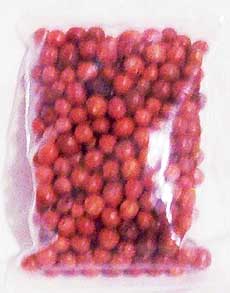
Chiltepines are tiny, round, fiery chiles.
Available at NativeSeeds.org. |
- Combine all ingredients in a bowl and whip until blended.
- Place the chicken portions in a dish that is wide enough that you can lay the pieces out side by side, with high enough sides so that the marinade can cover the chicken.
- Marinate overnight in the refrigerator.
Curry Chicken Stew
Ingredients
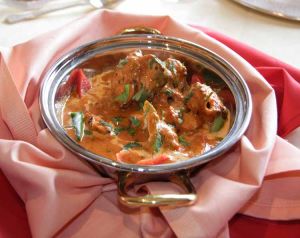 1 chicken, 6 to 8-pounds (oven stuffers work), cut into pieces as you like 1 chicken, 6 to 8-pounds (oven stuffers work), cut into pieces as you like - 1 large sweet potato, peeled
and cut into large cubes
- 1 medium yellow onion, sliced,
or 5-6 medium shallots, peeled
and left whole
- 2 large cloves of garlic, minced
- ½ piece of ginger, minced
- 4 cups chicken stock
- 1 cup coconut milk
- Salt to taste
- Cooking oil
Photo of curry by Sat Bhatti | IST.
Directions
- Heat two tablespoons of canola oil in a large dutch oven. Sauté the ginger, garlic and onions (these quantities should reflect your taste—if you like less ginger and more garlic, for example, adjust accordingly).
- Add some of the chicken portions and sear on all sides until they start to brown. Do this in batches, so as not to overload the pan, deglazing the pan with white wine in between batches. This helps keep the pan clean.
- Pour the deglazing liquid out into a bowl and reserve while you sear the next batch. When the last batch is done, put all the chicken back in, add the deglazing liquid, coconut milk and chicken stock enough to cover the chicken. Add the sweet potatoes. Cook for about 40 minutes, or until done.
Brown Rice
Ingredients
- 6 ounces brown rice (we used Uncle Ben’s—use your favorite brand)
- 2 large cloves garlic, cut into large cubes
- An equal amount of yellow onion, cut into large cubes
- ¼ cup coconut milk
- 2 cups chicken or vegetable stock
- 1 teaspoon honey
- Salt, pepper and fresh herbs to taste
Directions
- Salt the stock and cook the rice in it. Before the rice is completely cooked, add the garlic, onion, coconut milk and honey and stir well.
- When the rice is completely cooked, remove from fire, and add fresh herbs and salt and pepper to taste. Serves three.
Wine Pairings
We turned to the white wines that traditionally go best with spicy food: Gewürtztraminer (pronounced guh-VOORTS-truh-MEE-nur), Pinot Noir and Riesling (REEZ-ling). We chose bottlings from Alsace, France, which are traditionally vinified to be less sweet than their German cousins. Trimbach is a prominent producer, generally available and well priced. With their exotic fruit flavors, Gewürtz and Riesling may take time to “get to know,” if your palate is trained to the drier flavors of Chardonnay and Sauvignon Blanc; but put in the time and keep trying—it’s well worth it. (Our editorial director began life as a huge white Burgundy/Chardonnay fan, but now prefers a glass of Riesling or Gewürtz when she is just relaxing with a glass of white wine.)
- Trimbach Pinot Gris 2003 Reserve was the favorite ($14.00 to $17.00). Served well chilled, the wine had great balance between fruit and a bracing acidity that helped counteract the spiciness of the dish and actually worked beautifully with the sweet potatoes and ginger. The multiple flavors in the food and the wine communicated with each other. It also carried a bit of texture, as Pinot Gris can sometimes, and this slight oiliness (like the silkiness of extra virgin olive oil) also worked nicely. If you have deep pockets, try the wines of Zind-Humbrecht, the greatest producer in Alsace (in any variety they make—Gewürtztraminer, Pinot Gris, Pinot d’Alsace, Muscat and Riesling).
|
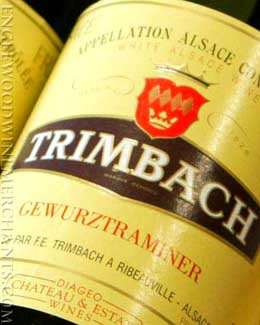
Trimbach Gewürtztraminer, available at
EnglewoodWineMerchants.com. |
- In Trimbach’s Gewürtztraminer 2004, flavors of ginger, lychee, white blossoms and apricot filled my mouth and a bit of spice hit my back palate ($14.00 to 18.00). Although the sweet fruit in the wine clashed with the sweet potatoes and muted the ginger in the dish, it was magic with the chicken itself, a fruity foil to the rich, spicy, savory curry.
Jerk Chicken
Here again, the key to great jerk is a great jerk seasoning. You can apply this seasoning to any meat, but traditionally, it is used on chicken—so that’s what we used on ours. There are various brands of jerk seasoning that come from Jamaica, including Grace’s and Glory Foods; but we had the pleasure of enjoying Chef Shehu’s (my husband, a professional chef) own homemade jerk seasoning.
Jerk Marinade
Ingredients
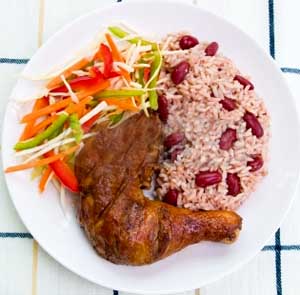 1 chicken, 6 to 8-pounds (oven stuffers work), cut into pieces as you like 1 chicken, 6 to 8-pounds (oven stuffers work), cut into pieces as you like - ½ yellow onion, roughly
chopped
- 3 cloves garlic, roughly
chopped
- ½ teaspoon fresh thyme
- 6 whole hot chiles*
- 2 teaspoons ground allspice
- ½ teaspoon black pepper
- 1 teaspoon red chile flakes
- 1 teaspoon ground ginger
- 2" piece fresh ginger,
roughly
chopped
- 3/4 teaspoon ground
cinnamon
- 3/4 teaspoon ground nutmeg
- ¼ teaspoon ground cloves
- Olive oil
- 3/4 cup malt vinegar
- 3/4 cup soy sauce
- 2 tablespoons dark rum
*Choose a chile based on your preference for heat: jalapeños are hot, habañeros are hotter, Jamaican Scotch Bonnets are much hotter. See our Chile Glossary for more information.
Directions
- Purée all ingredients in a food processor until liquefied. This should be a wet marinade, and it is O.K. if it is not completely smooth.
- Marinate the chicken for at least five hours.
- Roast in a preheated 375°F oven for 25 minutes or until done.
- Serving suggestions: brown rice with kidney beans, julienned vegetables vinaigrette.
Wine Pairings
Here we turned to Spain. Burgans Albariño is from Rìas Biaxas area of the Galicia region of northwestern Spain. The 2006 vintage we drank ($10.00 to $14.00) was the favorite wine for the jerk chicken, preferred over a Champagne, a cava, a dry Australian Riesling and a trio of reds. Thought to be Spain's finest white wine, Albariño is the white grape of the region of Galicia in northwest Spain. In Portugal, it is known as Alvarinho, and is often used in Vinho Verde (so-called because of its youthfulness) as well as to make Vinho Alvarinho.
Like Gewürtztraminer, Albariño has intense, perfumy aromas, although both wines are light on the palate. A classic Albariño has a nose of almonds or almond paste; some have pronounced apple, peach, lemon, floral and grass scents. However, whereas Gewürtz is a low-acid wine, Albariño has a bracing acidity that will appeal to many who like that style.
Burgans is one of the best labels in Albariño. Crisp, vibrant stone fruit and melon flavors in the Albariño balanced the spiciness of the chicken beautifully: a great pairing.
Well-chilled, crisp, fruity whites work better than reds overall to combat the rich, spicy flavors of these dishes. We also tried bubblies—Laurent Perrier Brut NV Champagne and Avinyo cava with the jerk chicken and some accra (saltfish fritters). Although the tasters enjoyed these as aperitifs (the Champagne better than the cava, which was more austere) they didn’t particularly enjoy them with the foods. |
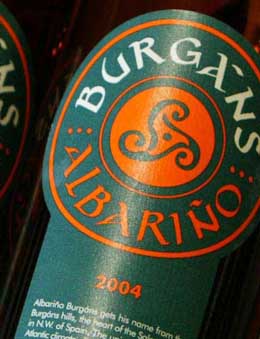
Burgans Albarino is available at
EnglewoodWineMerchants.com. |
Lively Caribbean music, and finding the right food and wine pairings, make for a good afternoon (or evening) with friends and family. If you’re not of Caribbean descent, it’s even more special!
Lifestyle Direct, Inc. All rights reserved. Images are the copyright of their respective owners.

|
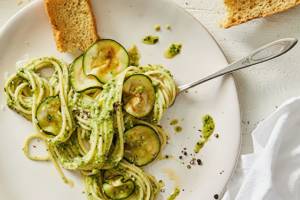
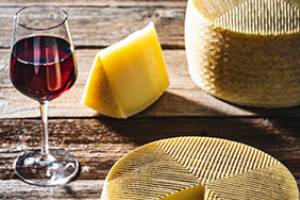



 with my saltfish (a.k.a. codfish—ackee and codfish is the national dish of Jamaica). Ackee isn’t cultivated outside of the Caribbean, but you can purchase canned ackee in Jamaican neighborhoods and online. The fruit was originally imported from West Africa, probably on a slave ship. The original name, ankye, comes from the Twi language of Ghana; its botanical, Blighia sapida, is in honor of Captain William Bligh of “Mutiny on the Bounty” fame, who first took the plants from Jamaica to England. The white-fleshed portion inside the thick red skin is eaten, but only when it is just ripe, as it is poisonous when overripe or underripe!
with my saltfish (a.k.a. codfish—ackee and codfish is the national dish of Jamaica). Ackee isn’t cultivated outside of the Caribbean, but you can purchase canned ackee in Jamaican neighborhoods and online. The fruit was originally imported from West Africa, probably on a slave ship. The original name, ankye, comes from the Twi language of Ghana; its botanical, Blighia sapida, is in honor of Captain William Bligh of “Mutiny on the Bounty” fame, who first took the plants from Jamaica to England. The white-fleshed portion inside the thick red skin is eaten, but only when it is just ripe, as it is poisonous when overripe or underripe! 
 1 chicken, 6 to 8-pounds (oven stuffers work), cut into pieces as you like
1 chicken, 6 to 8-pounds (oven stuffers work), cut into pieces as you like 
 1 chicken, 6 to 8-pounds (oven stuffers work), cut into pieces as you like
1 chicken, 6 to 8-pounds (oven stuffers work), cut into pieces as you like